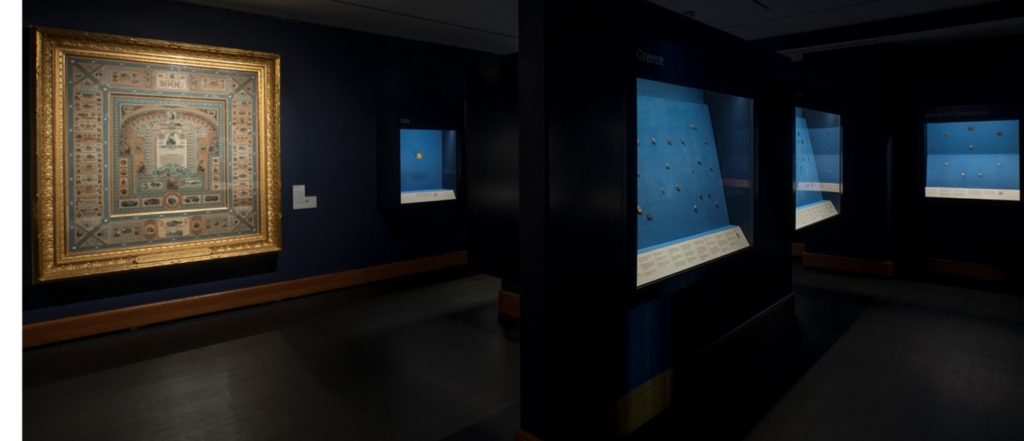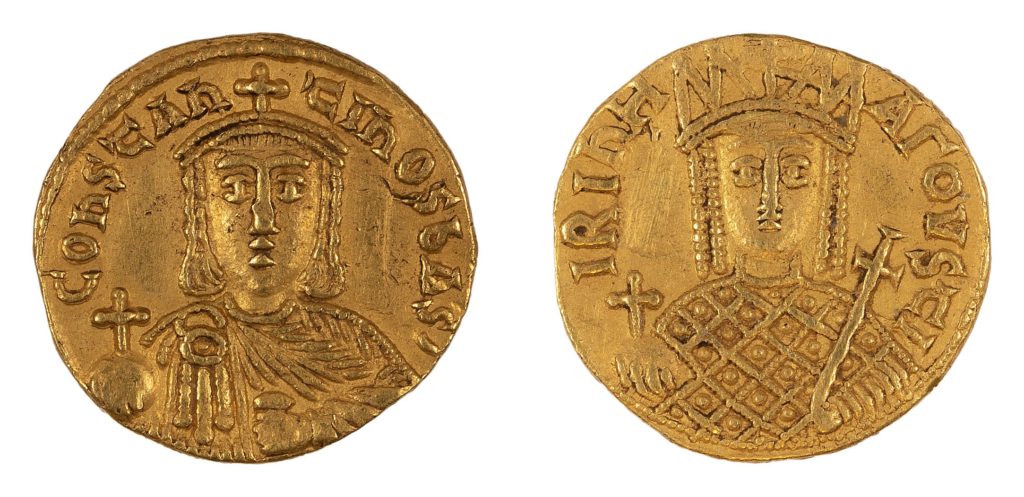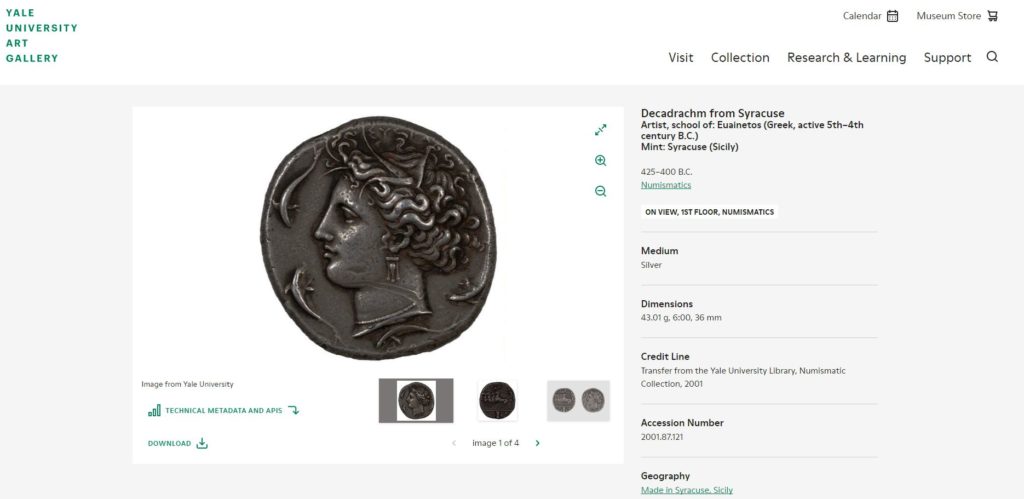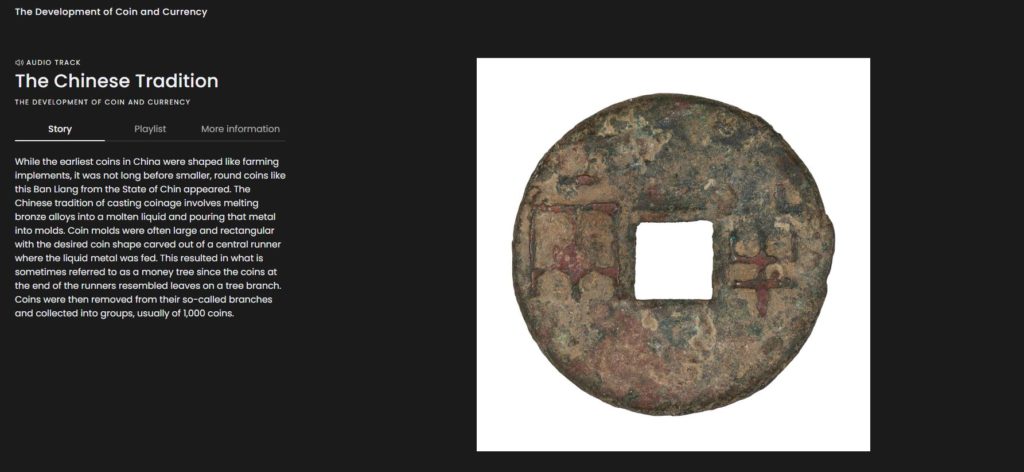February 17, 2024
The Bela Lyon Pratt Gallery of Numismatics: the Reunion Show

Emily Pearce Seigerman

In May 2022, the Yale University Art Gallery (YUAG) opened the doors to a new and inviting gallery dedicated to numismatics (Fig. 1). Named in honor of the renowned engraver, Bela Lyon Pratt, the gallery transformed the footprint of numismatics at the Art Gallery and the University. Through the creation of the Bela Lyon Pratt Numismatic Gallery, the department has been able to employ digital technologies to better highlight and emphasize objects displayed, thereby amplifying the visitor experience—a first for the YUAG. Being the first gallery within the museum to create a digital visitor experience—mostly through complementary media—is exciting, and further highlights the incredible beauty of numismatics and the Yale collection.

Large-scale digitization of the collection had not been attempted since 2009, when the Art Gallery began to catalog and photograph the numismatics solely for identification purposes (Fig. 2). The work completed during that time predominately documented the ancient holdings—one of the department’s strengths. Since then, student employees captured documentation-level images of the objects, until the interruption of the COVID-19 pandemic. The pandemic prevented both students and staff from working within the Art Gallery’s building, allowing for a full-scale assessment of the department’s collections data.

After initial assessment of the Collections Management System (CMS) and Digital Asset Management System (DAMS), staff discovered two key issues with the data. First, there was no data standard employed in how object cataloging information was recorded and, second, image quality and rate of error were far below the necessary level for effective use in any type of access setting (Fig. 3). There are approximately 120,000 numismatic object records in the Art Gallery’s Collections Management System (CMS). The Art Gallery employs The Museum System (TMS) as the CMS, meaning it uses the TMS relational database to document and track all collections objects. A relational database in simplest terminology, is a grouping of data tables that pivot off of one another, so for every object record there are myriad other datasets of information that inform and are informed by the object record. Staff spent much of 2020 completing detailed data manipulations and updates for more than 75,000 object records (a total of 900,000 data fields). Fields cleaned included Object Name (coin, currency, medal), Object Type, Medium, Period, Date, Credit Line (spelling edits), Culture, and Object Title. Most importantly, staff created a data standard for coin Object Titles and changed 52,558 object records’ Object Titles to this format. The data standard, so far only applied to coins and medals in the collection, has dramatically eased digital access to the collection both for staff and researchers by simplifying term required to query both via back-end and web platforms.[1]

With data cleaning near complete and a new data standard employed for all future additions to the collection, staff next addressed image capture processes and quality (Fig. 4). The Gallery utilized student labor to capture and input images into the CMS and DAMS for the past eight or so years. This is monotonous work and if one is not fully invested, mistakes will regularly occur. The data has a considerable number of inconsistencies or incorrect information—something that staff are actively working to correct. One example is the frequent association of incorrect images with object records.

To address incorrect image association, staff worked with YUAG Visual Resources and Information Technology (I.T.) departments to create a new digitization strategy for numismatic objects (Fig. 5). Moving forward, images will be captured by staff—unless a student demonstrates exceptional abilities—using a new image-capture set up. Staff use a Canon EOS 5D Mark IV DSLR camera, with a combination of the standard 24-105 mm lens and a 100 mm macro lens, tethered to a MacBook Air. Staff capture using the standard Canon software then manipulate images to the necessary specifications through Adobe Photoshop and Bridge. Images are then uploaded into the Yale Content Delivery System (CDS) by the Visual Resource department (Fig. 6).


Now with workable data and a plan for object digitization, staff could begin creating a digital interface to compliment the Bela Lyon Pratt Numismatic Gallery. In order to implement a technological launch-point, a major deviation from normal display mechanics in the Art Gallery, staff utilized QR code triggers that point users to label text (Fig. 7). For labels within the numismatic gallery, staff wanted to ensure that iconography and legend were directly highlighted for viewers, opting to have extremely brief sentences describing an object’s displayed side. To allow for further reflection on the objects, staff began working with the YUAG I.T. team to protype a QR code system to lead users to digital versions of each case, and then each coin, allowing for a deeper exploration into an object’s history, but only when desired.

The intention was to take users to the Gallery’s website and relevant object pages (Fig. 8). While staff continue to explore that avenue, it was determined that utilizing a program capable of satisfying some of the Gallery’s other needs, as well as staff desire for manipulatable QR codes, would be most advantageous at the current moment. YUAG contracted Smartify, a mobile application specializing in immediate, device-generated access to additional content for cultural heritage institutions, to facilitate some of the Gallery’s larger visitor service’s needs. The numismatics department is utilizing their QR code generator, data hosting, and more to fulfill the need for checklist-like additional content accessible in the gallery. Smartify is a relatively new program, founded in 2015, and available for iOS, Android, and as a web application (Fig. 9).

At the moment, the images at the top which illustrate the whole of the case, cannot be viewed individually (Fig. 10). Staff are working with Smartify to change that and hopefully in the next update, web visitors will be able to better view the case—something that was a major goal from the beginning. Smartify also allows us to host complementary media from other digital repositories-including SoundCloud, YouTube, and the Yale Art Gallery website.

Staff utilization of Smartify is still very much a work in progress but will allow for some exciting things coming down the pipeline. The next major step towards better audience engagement with the exhibition is a cluster of more-robust audio guides (Fig. 11). I mentioned that the Gallery is working with staff and faculty, but also with external professionals to reach a wider berth of visitors. The first tour takes visitors on a short, guided tour describing the developments and advancement of coin and currency through history. In this audio guided tour, the curators address the three minting traditions, development of portraiture, and industrialization of milled coinage. Staff anticipate working with faculty to create course-specific audio guides and tours, so that students can wander through the space while listening to their professor discuss whatever topic the courses address. This will be a tool offered not only to Students of Classics or History, but also East Asian Studies, American Studies, the School of Management, and beyond.

The numismatics department is keenly aware that the previous display space was incredibly inaccessible—lacking adequate space for visitors, interpretive text in languages other than English, and no content for visitors with low vision or blindness. The versatility of the Smartify program and the flexibility of using the application to host digital content—in multiple formats and languages—is allowing the department much greater control over content creation and deliverable timelines (Fig. 12). Staff are currently working with external parties mold several of the now-forming audio guides into alternative text experiences for visitors with low vision or blindness as well as deaf visitors. Themes like the development of coin and currency will be explored in a comparable manner to the aforementioned audio guide, but will deviate enough to describe the objects’ size, details, composition, and other necessary qualities of objects and cases to be a worthwhile and enjoyable visit for all guests.

While the Bela Lyon Pratt Numismatic Gallery is physically open, staff are far from finished making it as usable and accessible as possible (Fig. 13). The student and university community is first priority in content creation and educational opportunities. Nevertheless, as the largest university collection in North America, we are eager to exhibit this wonderful collection in a manner internationally and equitably accessible. The Yale Department of Numismatics invites you to explore both the digital media available through Smartify and the YUAG collections web portal, and if able to visit in New Haven. Stay tuned as the Yale numismatics team improves the digital catalog and for future Gallery rotations.
[1] Staff have also begun linking Object and Constituent data to authoritative databases including ULAN, VIAF, CSC, AAT, and Wikidata that will keep the records constantly up to date with current cultural heritage standards. This also preps records for use in LUX, Yale’s cross-campus discovery search portal as well as for any future data linking. This was begun by students under staff supervision since the end of the Spring 2020 semester with a total of approximately 23,835 object and constituent data fields linked.